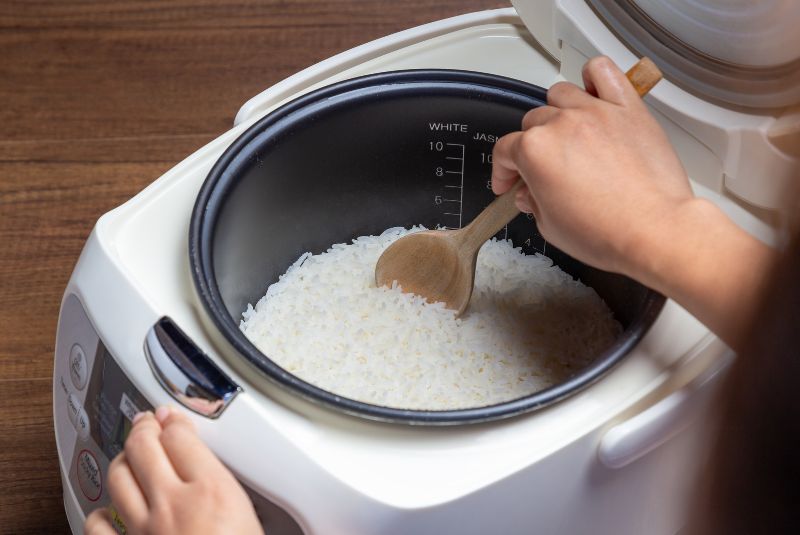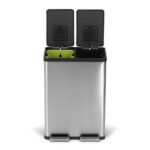Cooking rice in a pressure cooker can be a helpful and time-saving method for busy individuals looking for a quick and efficient way to prepare a staple food item. By utilizing a pressure cooker, you can significantly reduce the cooking time for rice while still achieving perfectly fluffy and flavorful results. This guide will walk you through the step-by-step process of cooking rice in a pressure cooker, allowing you to enjoy a delicious and satisfying meal with minimal effort.
[content-egg-block modules=AmazonNoApi template=offers_grid cols=3 groups=”SectionIntro” hide=rating]
Prepare Ingredients
- Gather all required ingredients such as rice, water, salt, and any additional seasonings that the recipe calls for.
- Check your pantry and fridge to ensure you have everything on hand before you begin cooking.
- Organize your ingredients on your countertop or workspace to make the cooking process smoother and more efficient.
[content-egg-block modules=AmazonNoApi template=offers_list groups=”Step1″ hide=rating]
Rinse Rice
- Rinse the rice under cold water in a fine-mesh strainer or a bowl.
- Swirl the rice around with your hand to wash off the starch until the water runs clear.
- Continue rinsing and swirling the rice several times until the water remains clear before cooking for fluffier results.
Add Rice and Water
Place the rinsed rice into the pressure cooker. Add water following the recommended rice to water ratio for the specific type of rice you are using. Make sure the rice is evenly distributed and fully submerged in the water. Cook according to your pressure cooker’s instructions.
Seasoning
- Add salt or any desired seasonings to the rice and water mixture.
- Stir well to evenly distribute the seasonings.
- Adjust the amount of salt or seasonings according to your taste preference.
- Continue with the cooking process as usual.
Pressure Cooking
Close the pressure cooker lid securely and set it to cook by following the cooker’s instructions for rice. Ensure the pressure valve is set to the sealing position. Let the rice cook according to the recommended time provided in the instruction manual. Once done, carefully release the pressure before opening the lid to avoid any steam burns.
Cooking Time
Allow the rice to cook for the specified time under pressure without opening the cooker. Ensure the pressure valve is closed and let the rice cook undisturbed until the timer goes off. Avoid releasing the pressure manually during this time as it may affect the cooking process. Once the cooking time is up, turn off the cooker and let the pressure release naturally before opening the lid.
Release Pressure
- Release Pressure: After cooking, release the pressure according to the pressure cooker’s specific release method.
- How to do it: Turn the pressure release valve to the “venting” position to quickly release the pressure inside the cooker.
- Safety first: Always use oven mitts or a kitchen towel to avoid burns from the escaping steam.
- Check for pressure: Ensure that all pressure has been released before opening the cooker to avoid any accidents.
Fluff and Serve
Open the lid of the rice cooker. Fluff the rice gently with a fork to separate the grains and release excess steam. Serve the fluffy rice hot as a versatile side dish or as a delicious base for a variety of main courses. Enjoy your perfectly cooked rice!
Wrap Up
Great job! Your conclusion sums up the key points nicely and leaves readers with a clear takeaway. Just make sure to encourage readers to try out the method for themselves and enjoy their perfectly cooked rice. Keep up the good work!
Essential Cooking Supplies
[content-egg-block modules=AmazonNoApi template=offers_list groups=”Materials”]
Pressure Cooker Rice Tips
Operating Instructions
- Read the instruction manual thoroughly to understand how to use the pressure cooker safely and effectively
- Begin by adding ingredients, liquid, and any seasonings to the pressure cooker pot according to the recipe you are following
- Ensure the pressure release valve is closed before setting the cooking time and pressure level
- Once cooking is complete, carefully release the pressure according to the instructions to avoid steam burns
- Open the pressure cooker carefully and enjoy your delicious meal!
Pressure Cooker FAQs
Yes, you can cook desserts in a pressure cooker! Pressure cookers are versatile appliances that can be used to prepare a variety of dishes, including desserts. Some popular desserts that can be made in a pressure cooker include cheesecake, puddings, cakes, and even rice pudding. The high pressure and heat in a pressure cooker help to cook desserts quickly and efficiently. Just be sure to follow a recipe specifically designed for pressure cookers to ensure the best results. Enjoy experimenting with making delicious desserts in your pressure cooker!
Using a pressure cooker to cook food can actually help retain more nutrients compared to other cooking methods. The high pressure and temperature inside a pressure cooker can cook food faster, which means less exposure to heat and water, both of which can cause nutrient loss. So, in general, pressure cooking can help preserve the nutritional value of your food better than boiling or other methods that involve longer cooking times.
No, you should not use a pressure cooker for canning food. Pressure cookers are not recommended for canning because they do not provide a consistent and reliable method of achieving the high temperatures needed to safely preserve food. It’s crucial to use a pressure canner that is specifically designed for canning to ensure the safety and quality of your canned food.
To safely release pressure from a pressure cooker, first, make sure to turn off the heat source. Then, depending on the model of your pressure cooker, there are two common methods to release pressure:
- Natural Release: Allow the pressure to reduce naturally by turning off the heat and letting the pressure cooker sit for a specific amount of time. This method is used for foods that benefit from additional cooking time or when you are not in a hurry.
- Quick Release: To release pressure quickly, use the quick release method by carefully turning the pressure release valve to the venting position. Be cautious of the hot steam that will escape. Once the pressure indicator has dropped, indicating that all pressure has been released, it is safe to open the pressure cooker.
Always follow the manufacturer’s instructions for your specific pressure cooker model to ensure safe pressure release. It’s essential to handle the pressure cooker with care to avoid any accidents.
Yes, you can cook a variety of dishes in a pressure cooker. Pressure cookers are versatile kitchen appliances that can be used to cook a wide range of dishes, from soups and stews to meats and vegetables. The high pressure and temperature inside the pressure cooker help to cook food faster than traditional cooking methods, making it a convenient option for busy cooks. Just be sure to follow the manufacturer’s instructions and recipes to ensure safe and successful cooking results.
Certainly! While pressure cookers are great for cooking food quickly and retaining nutrients, there are a few disadvantages to consider. One common concern is the potential for accidents if the cooker is not used properly, such as not releasing pressure before opening the lid. Also, some people find pressure cookers intimidating to use due to the high pressure involved. Additionally, certain foods may not turn out as expected when cooked in a pressure cooker, as the high pressure can affect textures and flavors. It’s important to follow safety guidelines and instructions when using a pressure cooker to avoid any potential drawbacks.
Sure! There are mainly two types of pressure cookers available in the market:
- Stovetop Pressure Cookers: These are the traditional type of pressure cookers that are used on a stovetop burner. They come in different materials like stainless steel or aluminum and are available in various sizes.
- Electric Pressure Cookers: Also known as multi-cookers, these are standalone appliances that have built-in pressure cooking functions. They are programmable, offering features like different cooking modes, timers, and safety mechanisms.
When using a pressure cooker, it’s important to follow these safety precautions:
- Read the manufacturer’s instructions carefully before using the pressure cooker.
- Ensure the pressure release valve is clear and not clogged before cooking.
- Never fill the pressure cooker above the recommended maximum fill line.
- Always use enough liquid in the pressure cooker to create steam and build pressure.
- Make sure the pressure cooker lid is properly sealed before cooking.
- Do not open the pressure cooker until all the pressure has been released.
- Use oven mitts or a kitchen towel when handling the pressure cooker, as it will be hot.
- When cleaning the pressure cooker, make sure all parts are completely dry before reassembling.
By following these safety precautions, you can safely use your pressure cooker to prepare delicious meals.
A pressure cooker works by trapping steam created from boiling water inside a sealed pot. This builds up pressure, which raises the boiling point of the water inside. The higher temperature allows food to cook faster than it would in a regular pot. The pressurized environment also helps to tenderize tough cuts of meat and infuse flavors more deeply into the food. Remember to always follow safety instructions when using a pressure cooker!
To clean and maintain a pressure cooker, start by disassembling the various parts such as the lid, gasket, and pressure release valve. Wash these parts with warm, soapy water and a sponge or soft cloth. Be sure to check the manufacturer’s instructions to see if these parts are dishwasher safe.
Next, wipe down the inside and outside of the pressure cooker with a damp cloth. Remove any food residue or stains using a non-abrasive cleaner. Dry all parts thoroughly before reassembling.
To maintain your pressure cooker, check the rubber gasket regularly for signs of wear and tear. Replace the gasket if it appears cracked or damaged. Also, inspect the pressure release valve for any blockages and clean it as needed.
Following these cleaning and maintenance tips will help ensure your pressure cooker functions properly and lasts for a long time.






